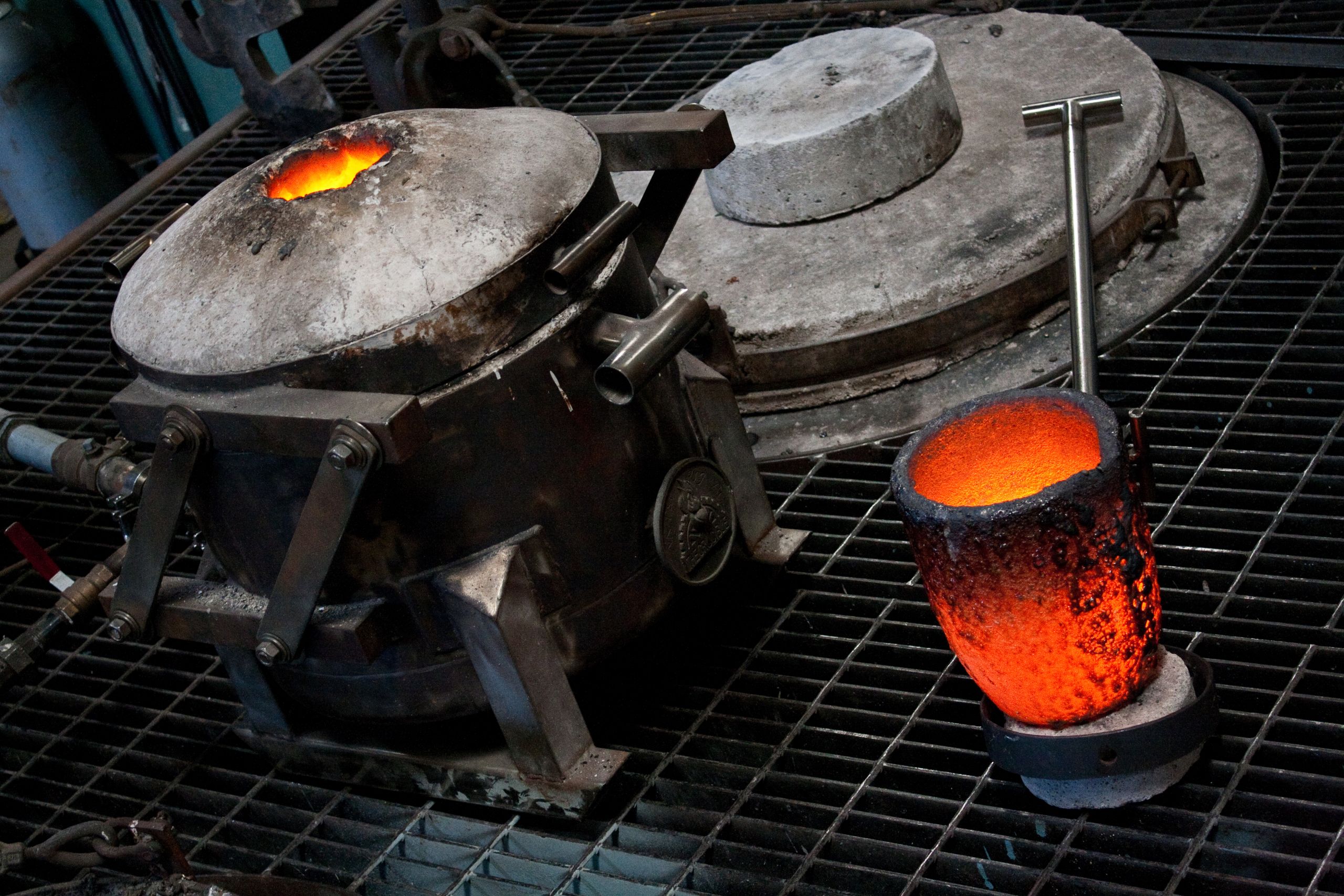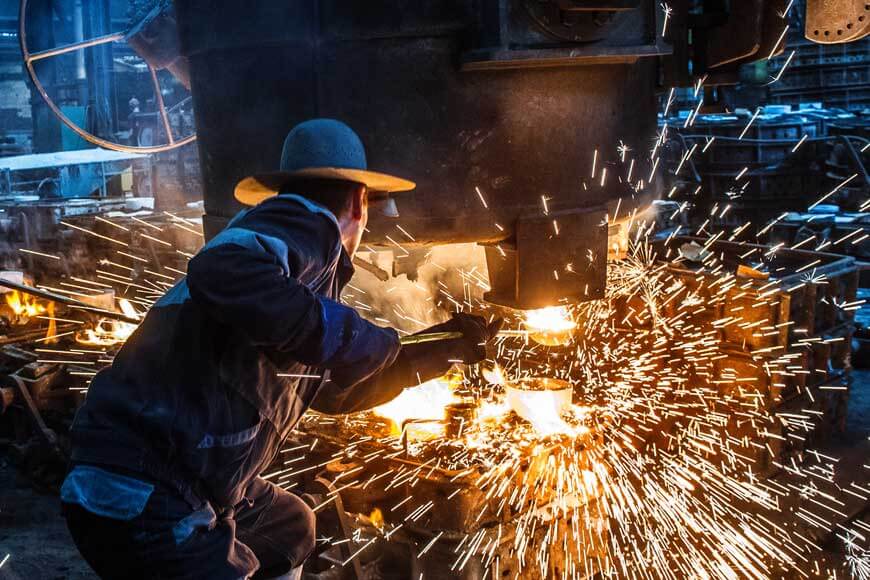How a Metal Foundry Combines Artistry and Precision
Wiki Article
Everything About Metal Casting: How Foundries Deliver High Quality and Precision in Production
Metal casting stands as a foundational procedure in manufacturing, where raw steels are transformed right into particular elements. Foundries employ various casting techniques to accomplish preferred forms and features. Each approach features its very own collection of restrictions and benefits. Recognizing these nuances is necessary for appreciating just how top quality and precision are maintained throughout the process. The discussion ahead will explore the complex characteristics of metal casting and its significance across numerous sectors.The Basics of Metal Casting
Metal casting is an essential process in manufacturing that includes forming liquified metal into wanted forms. This crucial strategy starts with the choice of resources, typically various metal alloys, which are melted in a furnace. As soon as the metal gets to the appropriate temperature, it comes to be prepared and liquid for casting.The procedure calls for a mold and mildew, generally made from sand, metal, or ceramic, which defines the final shape of the actors object. Once the molten metal is put right into the mold and mildew, it cools and solidifies, tackling the mold's shapes.
After cooling down, the casting is removed from the mold and mildew, and any essential completing processes, such as brightening or trimming, are carried out. This method enables producers to generate complicated shapes and components with high precision and very little waste. Metal casting is widely made use of across various industries, from automobile to aerospace, highlighting its value in modern manufacturing.
Kinds Of Casting Methods
While various casting approaches exist, each strategy is and supplies one-of-a-kind advantages suited for various applications. Sand casting, one of one of the most usual approaches, uses sand as the mold product, permitting for large components and detailed layouts. Financial investment casting, recognized for its precision, utilizes a wax pattern covered in ceramic, making it perfect for intricate geometries. Pass away casting, which entails forcing molten metal into molds under high stress, is often made use of for automation of small, detailed elements. Furthermore, covering molding integrates sand and resin to produce thinner, much more accurate mold and mildews, improving surface area coating. An additional approach, continuous casting, allows the production of long lengths of metal shapes, improving production procedures. Each of these techniques plays a pivotal duty in the metal casting industry, resolving particular demands from manufacturing quantity to make complexity, thus contributing to the diversity of applications across numerous markets.The Role of Foundries in Manufacturing
Foundries offer a vital feature in the production landscape, as they transform raw metals right into useful elements via various casting processes. These centers use a variety of methods to create products that satisfy precise specs, therefore making sure top quality and effectiveness in manufacturing (Metal Foundry). By using approaches such as sand casting, financial investment casting, and pass away casting, shops accommodate diverse industries, consisting of automotive, aerospace, and construction
Ultimately, shops are indispensable to the production ecological community, providing essential elements that sustain a vast variety of markets and applications. Their precision and flexibility drive efficiency in modern-day manufacturing.
Materials Used in Metal Casting
The option of products made use of in metal casting is necessary for accomplishing the preferred residential or commercial properties and performance of the end product. Numerous steels such as iron, bronze, and light weight aluminum are typically utilized, each offering distinctive benefits. Light weight aluminum is favored for its corrosion-resistant and lightweight high qualities, making it suitable for vehicle and aerospace applications. Iron, specifically cast iron, is understood for its superb fluidity and strength, appropriate for heavy equipment and facilities components. Bronze, with its premium wear resistance, is usually used in marine environments.Furthermore, products such as silica sand are regularly used for mold and mildew making, giving a great balance between resilience and ease of shaping. The choice of products additionally includes ingredients like changes, which boost the casting procedure by boosting fluidness and reducing oxidation. Ultimately, the appropriate selection of these materials substantially affects the effectiveness and quality of the casting process.
Quality assurance in the Casting Process
Quality assurance in the casting procedure is necessary to guarantee that last items meet sector requirements and specs. Numerous evaluation strategies are employed to recognize issues and examine the honesty of cast parts. Furthermore, adherence to developed certifications and requirements improves the dependability and efficiency of cast materials.Inspection Techniques Employed
Keeping the honesty of cast metal parts counts greatly on various inspection techniques. Foundries utilize visual inspections as an initial measure to determine surface problems, such as inclusions or cracks. Non-destructive screening (NDT) techniques, consisting of ultrasonic screening and radiographic examination, are vital for spotting internal problems without compromising the component's stability. Dimensional assessments utilizing calipers and coordinate measuring equipments validate that elements fulfill defined resistances. Furthermore, chemical evaluation verifies that the alloy structure aligns with called for criteria. These examination methods collectively confirm that the spreadings fulfill the necessary top quality and performance criteria, inevitably minimizing the risk of failure in their desired applications. Implementing these extensive assessments is basic for keeping high standards in metal casting production.Requirements and Certifications
Standards and accreditations play an essential role in the quality assurance of the casting process. Foundries abide by different international and industry-specific criteria, such as ISO 9001 and ASTM standards, ensuring consistency and integrity in their products. These standards lay out the essential criteria for products, manufacturing methods, and testing procedures, adding to a much more reliable production procedure. Accreditations, such as AS9100 for aerospace applications, additionally highlight the value of high quality guarantee in specialized markets. By obtaining these credentials, shops demonstrate their commitment to quality, decreasing flaws and improving client satisfaction. Regular audits and inspections verify conformity, cultivating continuous enhancement and development within the sector. Ultimately, adherence to established requirements grows trust in between have a peek at this website makers and customers.Innovations in Casting Technology

3D Printing Combination
Incorporating 3D printing innovation right into metal casting processes is reinventing the manufacturing landscape. This innovative blend enhances the layout and manufacturing of complicated geometries that typical methods battle to accomplish. By using additive production for producing mold and mildews and cores, factories can considerably minimize preparations and material waste. Moreover, 3D printing enables for rapid prototyping, visit this page making it possible for suppliers to evaluate styles promptly and successfully, consequently helping with repetitive renovations. This innovation additionally supports the manufacturing of lightweight parts, which are necessary in sectors like aerospace and automobile. As an outcome, the integration of 3D printing not just improves operations however additionally boosts the precision and quality of cast metal products, marking a notable innovation in the sector.Automated Production Processes
The advancements in 3D printing have actually led the way for further innovations in computerized production processes within metal casting. Foundries are significantly taking on robotics and automation to improve performance and precision. Automated systems enhance the entire casting process, from mold development to ending up and putting. Smart sensing units and real-time surveillance enable accurate control of temperatures and material circulation, lowering waste and enhancing quality. In addition, software application solutions help with better layout and simulation, making it possible for producers to optimize processes prior to production begins. These computerized manufacturing procedures not only lower labor expenses however also reduce human mistake, making sure consistent output. Because of this, the integration of innovative innovations in metal casting is reinventing production capacities and meeting the growing needs of numerous industries.Advanced Material Development
As markets require higher efficiency and sustainability, advancements in product development for metal casting are becoming an important focus. Scientists and designers are checking out brand-new alloys and compounds that boost mechanical homes while lowering ecological influence. Advancements include light-weight materials that maintain strength, enabling better fuel efficiency in transportation applications. In addition, the unification of recycled products is coming to be extra widespread, lining up with sustainability goals. Advanced casting techniques, such as 3D printing and precision molding, enable for the development of complex geometries that standard techniques can not accomplish. These developments not just boost the performance of actors parts but also improve manufacturing performance. In general, the continual advancement of product science drives the future of metal casting, satisfying the needs of modern-day markets.
Applications of Metal Casting Throughout Industries
Metal casting plays an important function in different industries, as it permits the manufacturing of intricate shapes and high-quality components visit homepage with loved one effectiveness - Metal Casting. In the vehicle industry, cast metals are crucial for developing engine blocks, transmission situations, and other important parts that need longevity and precision. Aerospace sectors utilize metal casting for elements like turbine blades and structural aspects, where reliability is vitalAdditionally, machinery and tools production benefit from metal casting by producing equipments, housings, and various other complex components that improve functionality. The construction sector additionally uses metal casting for architectural features, architectural supports, and fittings, showcasing adaptability.
The medical area counts on cast metals for surgical tools and implants, stressing the need for biocompatibility. On the whole, metal casting is a fundamental procedure throughout numerous sectors, offering options that fulfill rigid top quality standards and efficiency requirements.
Regularly Asked Questions
What Precaution Are Taken in Metal Casting Foundries?
In metal casting factories, safety actions consist of protective equipment, ventilation systems, routine devices upkeep, employee training, and emergency situation protocols to mitigate dangers connected with high temperatures, hazardous products, and possible mishaps throughout the casting process.Exactly How Do Foundries Take Care Of Waste and Environmental Influence?
Foundries handle waste and environmental influence via reusing materials, carrying out purification systems for emissions, and sticking to laws - Metal Foundry. They likewise embrace sustainable methods, such as minimizing power intake and making use of eco-friendly compounds in their processesWhat Are the Prices Connected With Metal Casting Processes?
The costs connected with metal casting procedures include basic materials, labor, equipment upkeep, energy intake, and waste monitoring. In addition, changes in market rates and conformity with environmental laws can significantly impact general costs for factories.How Does Metal Casting Compare to Other Production Techniques?
Metal casting offers distinct benefits, such as complicated forms and high product performance, compared to techniques like machining or stamping. Nonetheless, it may include longer preparations and higher first costs, relying on project requirements.
What Profession Opportunities Exist in the Metal Casting Industry?
The metal casting sector offers different career chances, consisting of factory administration, process design, quality control, mold style, and machine procedure. Specialists can additionally pursue functions in research study and development, sales, and ecological health and wellness.Metal casting stands as a fundamental procedure in manufacturing, where raw steels are transformed right into specific components. Metal casting is a basic process in producing that includes forming liquified metal right into desired forms. One more method, constant casting, enables the manufacturing of long sizes of metal forms, improving manufacturing procedures. The costs connected with metal casting processes include raw products, labor, equipment maintenance, power consumption, and waste administration. The metal casting sector offers numerous occupation possibilities, including factory management, procedure design, quality assurance, mold style, and equipment procedure.
Report this wiki page